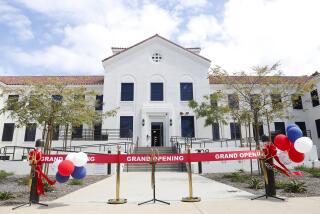Devastating Wait Often Follows Disability Claims
Helen Croxton lost her house during the fight for her disability payments. Miguel Hernandez lost his life.
Administrative law judges ultimately ruled that both were disabled and entitled to benefits. But the wait for justice was long and personally devastating, as it is for hundreds of thousands of other disabled people nationwide.
Last year, two-thirds of disability benefit denials were overturned by judges--involving 292,349 people who Social Security Administration workers decided were able to work. That figure is more than double what it was a decade earlier.
“The whole system is designed not to work,” said Elena Ackel, an attorney specializing in disability cases for Los Angeles’ Legal Aid Foundation. “All the effort is to let as few people on as possible.”
The agency is trying to correct the problems, officials say, but with such a huge system, change is costly and slow-moving.
The problem is twofold: Social Security officials have been under pressure to keep costs in check, and the number of people seeking disability benefits has ballooned 50% over the past decade, driven by an aging and growing population.
In the middle are harried federal workers, who each must decide the fate of about four people a day, generally working only from documents, with no time to talk with or meet the claimants.
And so, ailing people are left waiting month after month for money that can be crucial.
After a claim is denied, an applicant has 60 days to petition the agency’s Office of Hearings and Appeals. Within three years, the average appeal time has grown from 150 days to 340, and individual cases can stretch into years.
“The temptation is to up the turndown rate as a way of saving money,” said Rep. Barney Frank (D-Mass.), who has been involved in disability determination issues since he took office in 1980. “That’s terribly unfair. We’re talking about a group of people who are disabled. They’re frightened and in pain. It’s outrageous for the administration to make them wait a year or two for benefits.”
Miguel Hernandez of Whittier spent two years fighting the final battles of his life: one against lymphatic cancer and the other against the Social Security system.
Weeks after he was buried in December 1997, his widow, Amalia, found a check for $41,264 in the mailbox. Too late, Hernandez had won his legal fight to convince the government that he qualified for a monthly disability check.
“He never saw a dollar of it,” Amalia Hernandez said of her husband, a 51-year-old Vietnam War veteran who at the end was bedridden with tumors that bulged from his back. “Here’s someone who fought for his country, who went to war for his country. And when he needed his country, they turned the other way. It was like a slap in the face.”
Others have spent their life savings, waiting months without income. They frequently have gone into debt, and upon occasion have lost their homes.
‘They Put Me Through So Much’
Helen Croxton, a 57-year-old escrow officer from La Habra, was hit by a car and suffered back injuries so severe that she no longer could work. A Social Security caseworker determined that although Croxton was “in pain and discomfort,” she was able to hold a job. Benefits were denied.
The bank repossessed her home. She spent nearly $10,000 of her savings and retirement fund and piled up $16,000 in debt. She still wears arm and back braces, and cannot sit for more than 15 minutes or walk in a straight line. Sometimes, when she can’t stand, she must crawl to the bathroom.
After she had battled the agency for two years, an administrative law judge ruled Dec. 15, 1997, that Croxton was entitled to disability benefits.
“I really, truly think that they think that if they make it hard enough, many people would just give up,” she said. “And that’s what they want. I mean, they put me through so much, I was doubting my own sanity.”
In addition to its well-known role as a retirement fund, the U.S. Social Security Administration provides pensions for the permanently and long-term disabled, those who have exhausted the year of disability payments provided by the state.
The agency operates two programs, one a disability insurance plan for those who have paid into Social Security through their paychecks, and the Supplemental Security Income program for those who are disabled but have not paid into the system, such as children and legal immigrants.
Social Security officials would not comment on specific cases, but generally blame an overloaded system for the high rate of denials that later are overturned on appeal. This year alone, about 4,000 caseworkers must review more than 4 million new and old cases, from workers with terminal illnesses to children born with disabilities.
“It is very difficult to take on an enormously large undertaking such as this, and we’ve committed a lot of resources,” said Susan Daniel, deputy commissioner for Social Security in Washington, D.C. “It is doable . . . and we’re definitely going in the right direction.”
Critics of the agency express doubts about that, given the agency’s history.
Congressional reports dating back to the 1980s have alerted the agency to the problem, said Jane Ross, former director of income security issues for the General Accounting Office. Social Security has made some progress in tackling it, she said, but not nearly enough.
“If you’re not serious about solving a problem, you’ll just have another study,” Ross said. “They’ve studied this problem a lot.”
Between the two disability programs, the agency last year paid $64 billion to more than 8 million people, up from $57 billion the previous year. That growing price tag has resulted in efforts to contain costs by ferreting out applicants who are not legitimately disabled.
The administration uses guidelines for certain diseases that specify at what point applicants can qualify for disability.
Critics say the deserving too oftten get caught in the net.
Social Security has nothing to lose in denying benefits, said Ben Berkley, a Fullerton attorney who specializes in disability claims. The government does not have to pay a penalty or interest when judges rule in applicants’ favor, no matter how long they have waited for payment.
“This is a system that keeps getting worse and worse,” Berkley said. “Social Security makes them jump through hoops to prove that they are disabled. . . . Many end up falling along the way.”
Daniel said the initial decisions by caseworkers are often accurate. But many times, she said, a person’s disability worsens over time, resulting in a reversal at the hearing level. Or additional evidence submitted to the judge tips the scale in the applicant’s favor.
But an administrative law judge who hears such cases points out that the caseworkers seldom see the applicant. The judge does, “and sometimes, that makes a big difference.”
“This is a very difficult process,” said Lana Parke, the judge who hears cases in Long Beach. “You don’t do anybody any favors by telling them they’re disabled when they’re not. On the other hand, for someone who is disabled, we’re just about their only safety net.”
Another reason for the high number of overturned cases is that two sets of guidelines are used, one by judges and one for caseworkers.
Judges are bound by case law, which has established a more lenient definition of what constitutes a disability than the administration’s own guidelines. Rather than making decisions based on a disease’s stages, judges consider the effect the illness is having on the individual.
New Efforts to Bridge the Gaps
In an effort to bridge that gap and to reduce the number of successful appeals, Social Security last year told its judges that they should adhere to administration policy in most cases, not court precedent.
That prompted an outcry from the judges and the introduction of bills, pending in both the House of Representatives and Senate, to overturn the order.
At the same time, agency officials have begun to bridge the chasm between judges and caseworkers. In various pilot programs nationwide, disability examiners are asked to meet with applicants and to explain their reasoning in writing, a move aimed at encouraging more accurate decisions. A quality review panel, consisting of administrative law judges, also has been set up to monitor decisions at the hearing level “for consistency and quality,” Daniel said.
The agency has retrained all disability examiners, judges and others involved in the process, Daniel said. And it has reworked its guidelines to “make the disability process easier and more efficient for the American public.”
Kathryn Reed of Anaheim says the reforms are long overdue. Two years ago, she collapsed in a department store from what would turn out to be a rare genetic disease.
A team of physicians, from her family doctor to researchers at UCLA, concluded that she suffered from Ehlers-Danlos syndrome, a terminal disease that slowly causes connective tissue to lose elasticity and bones to fall apart.
But when she applied for disability benefits, agency examiners insisted she could work.
Reed, a 36-year-old mother of three, cannot climb steps without support. On good days, she loses her breath if she stands for more than 15 minutes; on bad days, she cannot muster the strength to sit up.
Reed said she and her husband, Dan, who took a second job, were overwhelmed by unpaid bills. They went on welfare and borrowed money from relatives to pay their $695 monthly rent. Even so, they were left with only about $35 a week for the rice and beans that became the family’s staple during her 18-month battle with Social Security.
Finally, in December, an administrative law judge overruled the agency and granted her benefits of $422 per month.
Reed’s experience convinced her that she was dealing with indifference bordering on callousness.
“I no longer trust the system, and I hate to say that because I was brought up to trust the system,” Reed said. “What they put me through was very degrading, not to mention just plain wrong.”
(BEGIN TEXT OF INFOBOX / INFOGRAPHIC)
Benefits Granted on Appeal
Record numbers of people who request disability benefits are being turned down by the Social Security Administration, only to be vindicated by appeals judges. Here are the numbers of appeal decisions from fiscal year 1986 to 1996:
1996: 485,737
Appeal Results:
1996: Awards -- 323,266
1996: Denials -- 162,471
*
Source: Office if Hearings and Appeals Key Workload indicators
More to Read
Sign up for Essential California
The most important California stories and recommendations in your inbox every morning.
You may occasionally receive promotional content from the Los Angeles Times.










